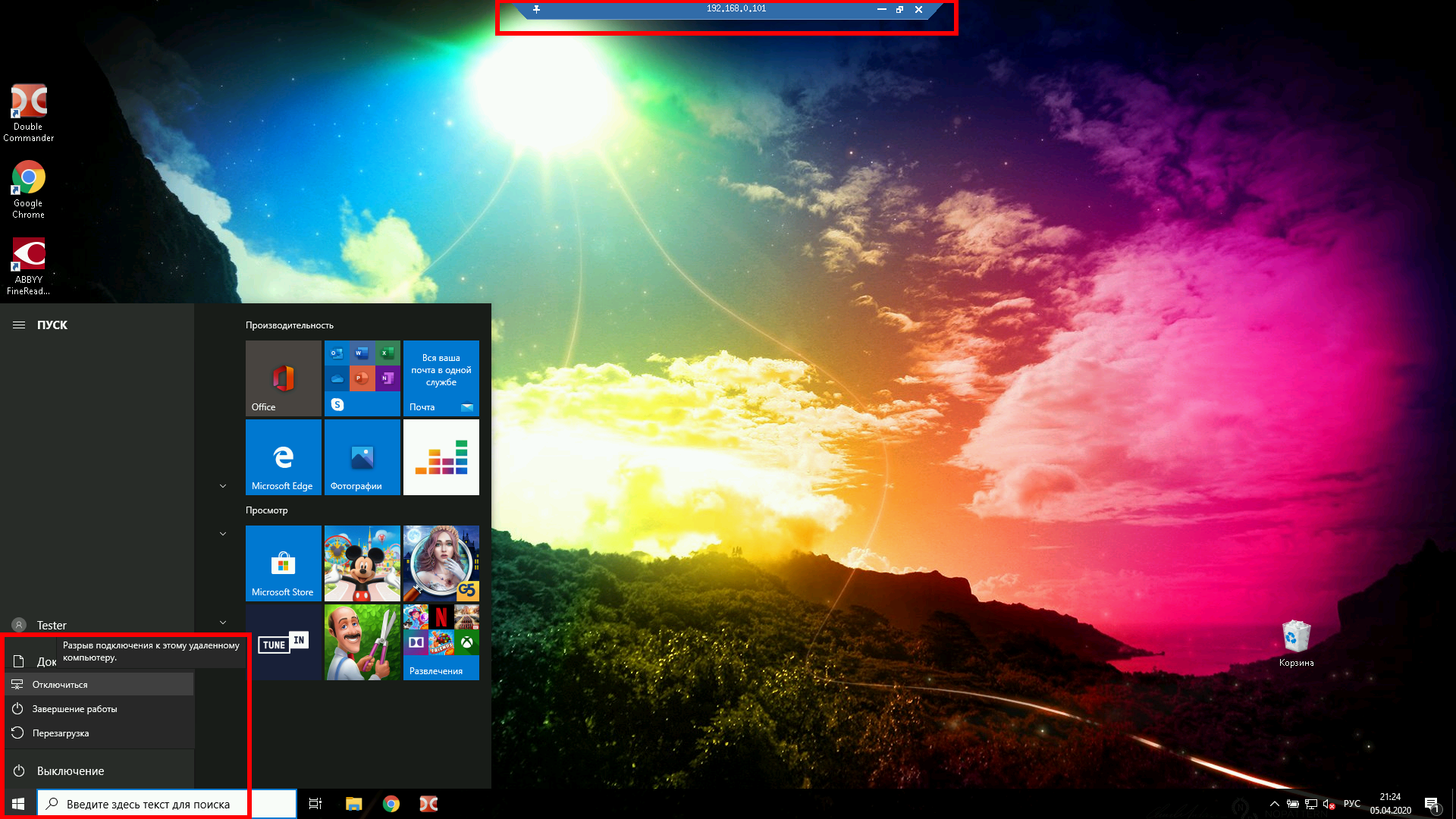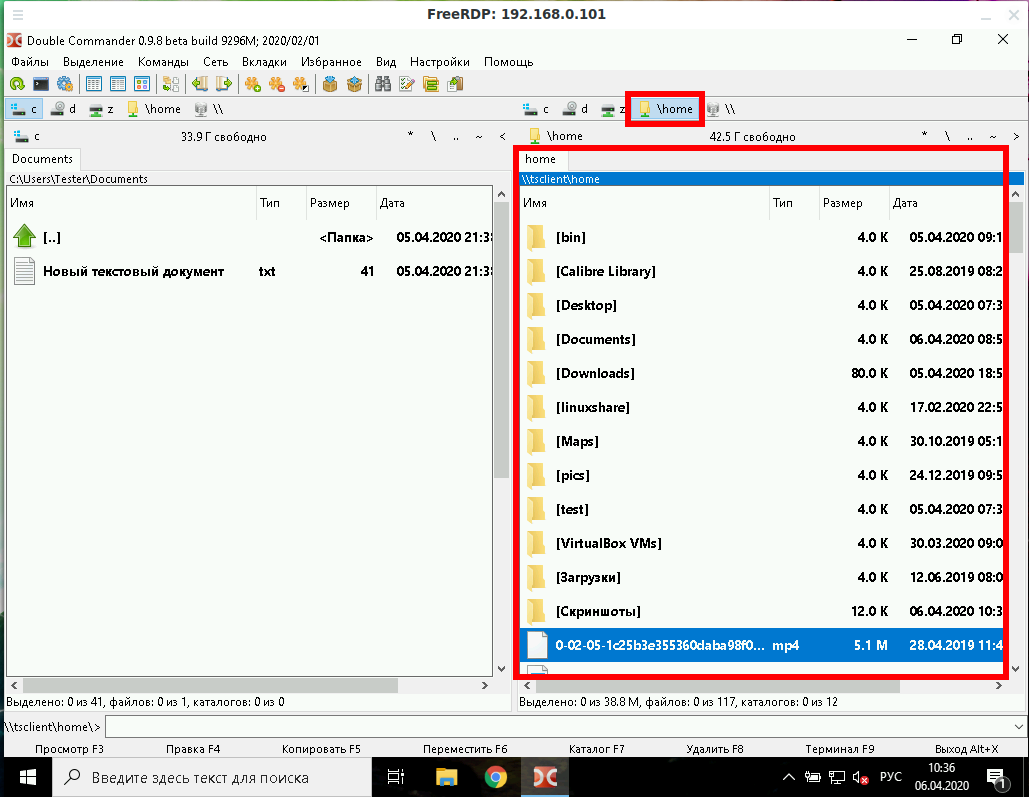Как из Linux подключиться к удалённому столу Windows по RDP
freerdp — это клиент RDP для подключения к удалённому рабочему столу из Linux.
Для установки freerdp в Debian, Kali Linux, Linux Mint, Ubuntu и производные выполните команду:
sudo apt install freerdp2-x11 freerdp2-shadow-x11
Если пакеты freerdp2-x11 и freerdp2-shadow-x11 не найдены, то поищите пакет с именем freerdp.
Для установки freerdp в Arch Linux и производные выполните команду:
Как подключиться командой freerdp
Для подключения к удалённому рабочему столу с помощью xfreerdp, запустите команду вида:
xfreerdp /f /u:ИМЯ-ПОЛЬЗОВАТЕЛЯ /p:ПАРОЛЬ /v:ХОСТ[:ПОРТ]
- /f — опция означает открыть удалённый стол в полноэкранном режиме
- /u:ИМЯ-ПОЛЬЗОВАТЕЛЯ — имя учётной записи на компьютере, к которому подключаемся
- /p:ПАРОЛЬ — пароль указанной учётной записи
- /v:ХОСТ[:ПОРТ] — IP адрес или имя компьютера, к удалённому столу которого выполняется подключение. ПОРТ указывать необязательно
Например, я хочу открыть удалённый стол компьютера с IP адресом 192.168.0.101, на котором имеется пользователь Tester с паролем 1234, причём я хочу открыть удалённый рабочий столк в полноэкранном режиме, тогда команда следующая:
xfreerdp /f /u:Tester /p:1234 /v:192.168.0.101
Для переключения между полноэкранным режимом и оконным, используется сочетание клавиш Ctrl+Alt+Enter.
При первом подключении появляется следующее сообщение о проблеме с сертификатом:
[11:02:36:086] [26320:26321] [INFO][com.freerdp.client.common.cmdline] - loading channelEx cliprdr [11:02:36:096] [26320:26321] [ERROR][com.freerdp.crypto] - @@@@@@@@@@@@@@@@@@@@@@@@@@@@@@@@@@@@@@@@@@@@@@@@@@@@@@@@@@@ [11:02:36:096] [26320:26321] [ERROR][com.freerdp.crypto] - @ WARNING: CERTIFICATE NAME MISMATCH! @ [11:02:36:096] [26320:26321] [ERROR][com.freerdp.crypto] - @@@@@@@@@@@@@@@@@@@@@@@@@@@@@@@@@@@@@@@@@@@@@@@@@@@@@@@@@@@ [11:02:36:096] [26320:26321] [ERROR][com.freerdp.crypto] - The hostname used for this connection (192.168.0.101:3389) [11:02:36:096] [26320:26321] [ERROR][com.freerdp.crypto] - does not match the name given in the certificate: [11:02:36:096] [26320:26321] [ERROR][com.freerdp.crypto] - Common Name (CN): [11:02:36:096] [26320:26321] [ERROR][com.freerdp.crypto] - HackWare-MiAl [11:02:36:096] [26320:26321] [ERROR][com.freerdp.crypto] - A valid certificate for the wrong name should NOT be trusted! Certificate details: Subject: CN = HackWare-MiAl Issuer: CN = HackWare-MiAl Thumbprint: 6a:4c:be:35:23:5f:46:b5:bd:37:15:5e:f7:21:ec:59:aa:c1:1c:3e The above X.509 certificate could not be verified, possibly because you do not have the CA certificate in your certificate store, or the certificate has expired. Please look at the OpenSSL documentation on how to add a private CA to the store. Do you trust the above certificate? (Y/T/N)

Поскольку используются самоподписанные сертификаты без добавленного в хранилище приватного CA (центра аутентификации, удостоверяющего центра), то единственный выбор, это согласиться доверять указанному сертификату, для этого введите Y.
В полноэкранном режиме вы можете отключиться от удалённого рабочего стола двумя способами:

Для запуска в оконном режиме не используйте опцию /f:
xfreerdp /u:Tester /p:1234 /v:192.168.0.101

Опции xfreerdp
У программы xfreerdp множество опций, далее выбраны самые интересные из них:
/v:[:ПОРТ] Имя хоста сервера с RDP /u. Имя пользователя /p: Пароль /f Полноэкранный режим (++ переключает полноэкранный режим) /port: Порт сервера /size. Размер экрана /w: Ширина /h: Высота /monitor-list Вывести список обнаруженных мониторов /monitors:[, [. ]] Выбрать мониторы для использования -grab-keyboard Отключить захват клавиатуры -mouse-motion Отключить отправку движений мыши /log-level. Установить уровень журналирования по умолчанию, подробности смотрите в wLog(7) +home-drive Сделать домашнюю папку пользователя совместной с удалённым столом /drive:, Подключить директорию как шару с именем +drives Включить перенаправление всех точек монтирования как совместных папок /ipv6 Предпочитать IPv6 AAAA запись, а не IPv4 A запись /t: Заголовок окна /kbd:0x или Раскладка клавиатуры /kbd-fn-key: Значение функциональной клавиши /kbd-list Вывести список раскладок клавиатуры /kbd-subtype: Подтип клавиатуры /kbd-type: Тип клавиатуры
Как в freerdp создать общие папки
С удалённым рабочим столом, подключённым по RDP, можно иметь совместные папки. Рассмотрим несколько примеров.
Чтобы подключить все точки монтирования в текущей системе как совместные папки на удалённом рабочем столе используйте опцию +drives, например:
xfreerdp /u:Tester /p:1234 /v:192.168.0.101 +drives
На скриншоте показан удалённый стол Windows, в котором доступны папки Linux системы, из которой сделано подключение по RDP:

Чтобы подключить только домашнюю папку текущего пользователя Linux в качестве сетевой папки к компьютеру по RDP укажите опцию +home-drive:
xfreerdp /u:Tester /p:1234 /v:192.168.0.101 +home-drive
В этом случае домашняя папка смонтирована в систему, подключённую по протоколу удалённый рабочий стол:

С опцией /drive:ИМЯ,/ПУТЬ/В/LINUX можно подключить любую папку с любым именем. В качестве /ПУТЬ/В/LINUX должен быть указан путь в текущей системе, а ИМЯ это то имя, которое будет иметь шара в удалённой системе. Например, чтобы подключить корневую папку текущей системы (/) к удалённой с именем root:
xfreerdp /u:Tester /p:1234 /v:192.168.0.101 /drive:root,/
Как вывести удалённый рабочий стол на другой монитор
Если у вас несколько мониторов, то вы можете выбрать, какой из них использовать для удалённой системы. Чтобы вывести список мониторов запустите команду:
Выбранный идентификатор монитора (или нескольких мониторов) укажите с помощью опции /monitors:[, [,…]].
Как установить размер окна удалённого рабочего стола
В следующем примере выполняется подключение к хосту rdp.contoso.com с именем USER и размером 50 процентов от высоты.
xfreerdp /u:USER /size:50%h /v:rdp.contoso.com
Если вместо высоты (h) установлена ширина (w), примерно как /size:50%w, то будет использоваться 50 процентов ширины.
Связанные статьи:
How to map a network drive?
I am unable to map a Windows network drive in Ubuntu. I executed the following command in the terminal:
karthick@karthick:~$ sudo mount -t cifs -o username=raghu //172.29.32.184 /media/Data/ Password: mount error(2): No such file or directory Refer to the mount.cifs(8) manual page (e.g. man mount.cifs) It’s generally accepted that you should manually mount to /mnt/ , while /media/ is for system managed mounts (such as a USB).
6 Answers 6
I think you need to also pass the windows share name as well as confirm that you’ve created /media/Data
to list the shares, then append the share name to your mount
sudo mount -t cifs -o username=raghu //172.29.32.184/sharename /media/Data/ - Note- If you receive the error: wrong fs type, bad option, bad superblock on. make sure you have cifs-utils installed, it may not be installed on your distro by default. sudo apt-get install cifs-utils
If you need to mount your windows share permanently then there is an excellent HowTo by dmizer UbuntuForums Staff (scroll to the permanent mount section)- I wont reproduce the advice here because its got some excellent debugging hints and tips and other workarounds that you may encounter.
Spot on. In order to map a share (even using Windows as the client) you have to point directly at a share. You can’t mount the entire computer and you can’t [directly] mount a subdirectory of the share.
I have followed your instruction, but i am getting the following error.mount error(11): Resource temporarily unavailable Refer to the mount.cifs(8) manual page (e.g. man mount.cifs)
@karthick87 — thats a new one on me — maybe worth posting that one on that active forum thread. The only google search on this error that I found that vaguely might be related is this one: linuxquestions.org/questions/linux-server-73/…
The following did the trick: mount -t cifs -o ‘username=domain\uname’ ‘\\machine\folder’ /mnt/folder . Worked on Redhat as well.
- open a Nautilus window
- click Go in the menu, or alternatively press Ctrl+L
- enter smb://remote_host/share_name
- Go to Bookmarks and click add
@DavidCole-GrammarPolice I’d disagree: as long as this answer is offering a different solution, it does have value and use. (didn’t check the meta for an official take on these issues. )
I think this way will work as long as you are using Nautilus. I am not sure if it works when you use another Gnome file manager
Thank you for posting an alternative that’s more user-friendly and doesn’t require sudo for normal users! I can confirm that the above works for Kubuntu’s Dolphin on Ubuntu 17.04 .
This solution did not have the smb mounted share name appear in my file system. I did however help me get past copying files back and forth so it did help me. The other solutions are giving me permission denied errors (I’m trying to track that down).
I use @fossfreedom’s answer in one line command use this :
echo '' | sudo -S mkdir /mnt/sharedfolder/ | sudo -S mount -t cifs -w -o username=nabed -o password=nabed //192.168.0.58/sharedfolder /mnt/sharedfolder/ Download VisiPics and install it with Wine.
Mount the shared folder if it exists:
sudo -S mkdir /mnt/sharedfolder/ sudo -S mount -t cifs -w -o username=nabed -o password=nabed //192.168.0.58/sharedfolder /mnt/sharedfolder/ Then go to VisiPics and open Z: drive and folder /mnt . Inside you will find the network data.
Geeqie does great job too and has an Ubuntu version.
As of 2020 this is what works for me on Ubuntu 18.04:
- open the Nautilus file manager
- press Ctrl+l to write into the address bar
- insert sftp://your_user_name@target_ip_address where target_ip_address should have the form 102.69.35.384 , then just press Enter to confirm
Now you will be asked for the log-in user name and password. That’s it, you should now have a graphical connection in Nautilus to the drive
That will work, but technically it’s not mounting a share. You mount a share by it’s name, without knowing the path to it’s location on disk. Your solution mounts a users homedir and emulates a filesystem via sftp protocol.
@SorenA I guess you are right, I am a newbie and not really aware of the terminology. What is then my suggestion doing — «mapping» a drive? Where is the difference in use to «mounting»? Thanks
Another way is to use the file browser to connect to a network location. Then it is mounted under ~/.gvfs
From there, you can mkdir ~/winbox and then ln -s ~/.gvfs/blahblahblah ~/winbox .
I recall there being some permanence to this, but I forget the details. 😛 I was developing php/odbc app for Quickbooks which needs to be run on the Quickbooks computer.
Edit for 2018 and beyond: After 14.04, ubuntu seems to no longer use .gvfs , so the above might not work for you. Some folks got really mad that something changed and my old answer didn’t work.
Check out this comment: ~/.gvfs moved to /run/user/[UID]/gvfs/blahblah . After using Nautilus to make a location using sftp://host:port , the remote server’s file system showed up there.